Latrodectus
| Latrodectus | |
|---|---|
| Scientific classification | |
| Kingdom: | Animalia |
| Phylum: | Arthropoda |
| Subphylum: | Chelicerata |
| Class: | Arachnida |
| Order: | Araneae |
| Infraorder: | Araneomorphae |
| Family: | Theridiidae |
| Genus: | Latrodectus Walckenaer, 1805[1] |
| Species | |
|
31 described species,[2] estimated 65 species living | |
Latrodectus is a genus of spiders in the family Theridiidae, most of which are commonly known as widow spiders. The genus contains 31 recognized species[2] distributed worldwide, including the North American black widows (L. mactans, L. hesperus, and L. variolus), the button spiders of Africa, and the Australian redback spider. Species vary widely in size. In most cases, the females are dark-coloured and readily identifiable by reddish markings on the abdomen, which are often hourglass-shaped.
These small spiders have an unusually potent venom containing the neurotoxin latrotoxin, which causes the condition latrodectism, both named after the genus. Female widow spiders have unusually large venom glands and their bite can be particularly harmful to large vertebrates, including humans. However, despite the genus' notoriety, Latrodectus bites are rarely fatal or even produce serious complications. Only the bites of the females are dangerous to humans.
Description
Female widow spiders are typically dark brown or a shiny black in colour when they are full grown, usually exhibiting a red or orange hourglass on the ventral surface (underside) of the abdomen; some may have a pair of red spots or have no marking at all. The male widow spiders often exhibit various red or red and white markings on the dorsal surface (upper side) of the abdomen, ranging from a single stripe to bars or spots, and juveniles are often similar to the male pattern. Females of a few species are paler brown and some have no bright markings. The bodies of black widow spiders range from 3–10 millimetres (0.12–0.39 in) in size; some females can measure 13 millimetres (0.51 in) in their body length.[3]
Behavior
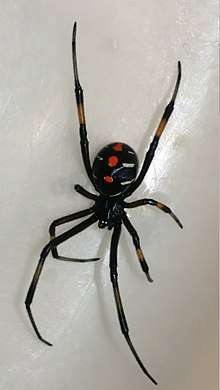
The prevalence of sexual cannibalism, a behavior in which the female eats the male after mating, has inspired the common name "widow spiders".[4] This behaviour may promote the survival odds of the offspring;[5] however, females of some species only rarely show this behaviour, and much of the documented evidence for sexual cannibalism has been observed in laboratory cages where the males could not escape. Male black widow spiders tend to select their mates by determining if the female has eaten already to avoid being eaten themselves. They are able to tell if the female has fed by sensing chemicals in the web.[6][7]
Like other members of the family Theridiidae, widow spiders construct a web of irregular, tangled, sticky silken fibres. Black widow spiders prefer to nest near the ground in dark and undisturbed areas, usually in small holes produced by animals, or around construction openings or wood piles. Indoor nests are in dark, undisturbed places as well such as under desks or furniture or in a basement.[8] The spider frequently hangs upside down near the centre of its web and waits for insects to blunder in and get stuck. Then, before the insect can extricate itself, the spider rushes over to envenomate and wrap it in silk. To feed, the mouth pulses digestive juices over the prey which is liquified and then internalized by capillary action, allowing the slurry to be sucked back up into the mouth.[9][10] Their prey consists of small insects such as flies, mosquitoes, grasshoppers, beetles, and caterpillars.[10] If the spider perceives a threat, it quickly lets itself down to the ground on a safety line of silk. As with other web-weavers, these spiders have very poor eyesight and depend on vibrations reaching them through their webs to find trapped prey or warn them of larger threats. When a widow spider is trapped, it is unlikely to bite, preferring to play dead or flick silk at the potential threat; bites occur when they cannot escape.[11] Many injuries to humans are due to defensive bites delivered when a spider gets unintentionally squeezed or pinched.
The ultimate tensile strength and other physical properties of Latrodectus hesperus (western black widow) silk were found to be similar to the properties of silk from orb-weaving spiders that had been tested in other studies. The tensile strength for the three kinds of silk measured in the Blackledge study was about 1,000 MPa. The ultimate strength reported in a previous study for Nephila edulis was 1,290 ± 160 MPa.[12] The tensile strength of spider silk is comparable to that of steel wire of the same thickness.[13] However, as the density of steel is about six times that of silk,[14] silk is correspondingly stronger than steel wire of the same weight.
Spiders of the genus Steatoda (also of the Theridiidae) are often mistaken for widow spiders, and are known as "false widow spiders"; they are significantly less harmful to humans.
Taxonomy
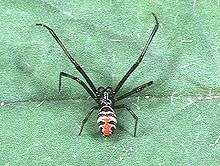
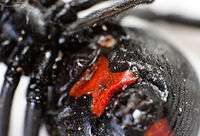
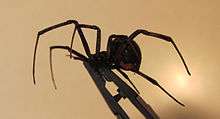
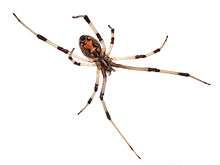
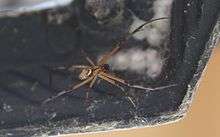
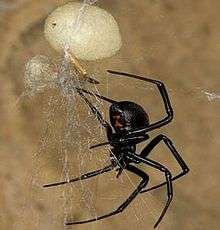
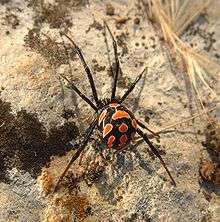
The genus Latrodectus was erected by Walckenaer in 1805, for the species Latrodectus tredecimguttatus and Latrodectus mactans.[1][15] Arachnologist Herbert Walter Levi revised the genus in 1959, studying the female sexual organs and noting their similarity across described species. He concluded the colour variations were variable across the world and were not sufficient to warrant species status, and reclassified the redback and several other species as subspecies of the black widow spider.[16]
Levi also noted that study of the genus had been contentious; in 1902, both F.P Cambridge and Friedrich Dahl had revised the genus, with each criticising the other. Cambridge questioned Dahl's separating species on what he considered minor anatomical details, and the latter dismissed the former as an "ignoramus".[16]
Species
As of July 2017, the World Spider Catalog accepted the species listed below.[1]
- Latrodectus antheratus (Badcock, 1932) – Paraguay, Argentina
- Latrodectus apicalis Butler, 1877 – Galapagos Is.
- Latrodectus bishopi Kaston, 1938 – US
- Latrodectus cinctus Blackwall, 1865 – Cape Verde Is., Africa, Kuwait, Iran
- Latrodectus corallinus Abalos, 1980 – Argentina
- Latrodectus curacaviensis (Müller, 1776) – Lesser Antilles, South America
- Latrodectus dahli Levi, 1959 – Morocco to Central Asia
- Latrodectus diaguita Carcavallo, 1960 – Argentina
- Latrodectus elegans Thorell, 1898 – India, Myanmar, China, Japan
- Latrodectus erythromelas Schmidt & Klaas, 1991 – India, Sri Lanka
- Latrodectus geometricus C. L. Koch, 1841 – Cosmopolitan
- Latrodectus hasselti Thorell, 1870 – Southeast Asia to Australia, New Zealand
- Latrodectus hesperus Chamberlin & Ivie, 1935 – North America, Israel
- Latrodectus hystrix Simon, 1890 – Yemen, Socotra
- Latrodectus indistinctus O. Pickard-Cambridge, 1904 – Namibia, South Africa
- Latrodectus karrooensis Smithers, 1944 – South Africa
- Latrodectus katipo Powell, 1871 – New Zealand
- Latrodectus lilianae Melic, 2000 – Spain, Algeria
- Latrodectus mactans (Fabricius, 1775) – probably native to North America only (introduced elsewhere)
- Latrodectus menavodi Vinson, 1863 – Madagascar, Comoro Is., Aldabra
- Latrodectus mirabilis (Holmberg, 1876) – Argentina
- Latrodectus obscurior Dahl, 1902 – Cape Verde Is., Madagascar
- Latrodectus pallidus O. Pickard-Cambridge, 1872 – Cape Verde Is., Libya to Central Asia
- Latrodectus quartus Abalos, 1980 – Argentina
- Latrodectus renivulvatus Dahl, 1902 – Africa, Saudi Arabia, Yemen, Iraq
- Latrodectus revivensis Shulov, 1948 – Israel
- Latrodectus rhodesiensis Mackay, 1972 – Southern Africa
- Latrodectus thoracicus Nicolet, 1849 – Chile
- Latrodectus tredecimguttatus (Rossi, 1790) (type species) – Mediterranean to China
- Latrodectus variegatus Nicolet, 1849 – Chile, Argentina
- Latrodectus variolus Walckenaer, 1837 – US, Canada
Distribution
Widow spiders can be found on every continent of the world except Antarctica. In North America, the black widows commonly known as southern (Latrodectus mactans), western (Latrodectus hesperus), and northern (Latrodectus variolus) can be found in the United States, as well as parts of southern Canada – particularly in the Okanagan Valley of British Columbia, as can the "gray" or "brown widow spiders" (Latrodectus geometricus) and the "red widow spiders" (Latrodectus bishopi).[17] The blue mud dauber (Chalybion californicum) is a wasp that, in the Western United States, is the primary predator of black widow spiders.[18]
The most prevalent species occurring in eastern Asia and Australia is commonly called the redback (Latrodectus hasselti).
Bite
Due to the presence of latrotoxin in their venom, black widow bites are potentially dangerous and may result in systemic effects (latrodectism) including severe muscle pain, abdominal cramps, hyperhidrosis, tachycardia, and muscle spasms.[19] Symptoms usually last for 3–7 days, but may persist for several weeks.[20]
In the United States each year, about 2,200 people report being bitten by a black widow, but most do not need medical treatment. Some bites have no venom injected, a "dry" bite. Each year 12 bites are considered serious but no deaths have been reported in 100 years. Black widows are not especially aggressive spiders, and they rarely bite humans unless startled or otherwise threatened.[21]
Contrary to popular belief, most people who are bitten suffer no serious damage, let alone death. Fatal bites were reported in the early-20th century mostly with Latrodectus tredecimguttatus, the Mediterranean black widow.[22]
Since the venom is not likely to be life-threatening, antivenom has been used as pain relief and not to save lives.[23] However, a study demonstrated that standardized pain medication, when combined with either antivenom or a placebo, had similar improvements in pain and resolution of symptoms.[23]
See also
References
- 1 2 3 "Gen. Latrodectus Walckenaer, 1805", World Spider Catalog, Natural History Museum Bern, retrieved 2016-01-28
- 1 2 "Species list for Latrodectus". World Spider Catalog. Natural History Museum Bern. Retrieved 2016-01-28.
- ↑ "Black Widow Spiders". Orkin Pest Control. Retrieved 19 June 2017.
- ↑ Breene, R. G.; Sweet, M. H. (1985). "Evidence of insemination of multiple females by the male Black Widow Spider, Latrodectus mactans (Araneae, Theridiidae)" (PDF). The Journal of Arachnology. 13 (3): 331–335.
- ↑ "Male spiders let females eat them for kids' sake: Study". livescience. 23 December 2011. Retrieved 23 December 2011.
- ↑ Johnson, J. Chadwick; Trubl, Patricia; Blackmore, Valerie; Miles, Lindsay (August 2011). "Male black widows court well-fed females more than starved females: silken cues indicate sexual cannibalism risk". Animal Behaviour. 82 (2): 383–390. doi:10.1016/j.anbehav.2011.05.018.
- ↑ Baruffaldi, Luciana; Andrade, Maydianne C.B. (April 2015). "Contact pheromones mediate male preference in black widow spiders: avoidance of hungry sexual cannibals?". Animal Behaviour. 102: 25–32. doi:10.1016/j.anbehav.2015.01.007.
- ↑ "Black Widow Spider - Facts, Bite & Habitat Information". Animal Corner. Retrieved 4 November 2016.
- ↑ Eberhard, W G (2006). "The mystery of how spiders extract food without masticating prey" (PDF). Bulletin of the British Arachnological Society. 13 (9): 372–6.
- 1 2 "Black Widow Spiders". National Geographic. 10 September 2010. Retrieved 19 June 2017.
- ↑ Nelsen, David; Kelln, Wayne; Hayes, William (2014). "Poke but don't pinch: risk assessment and venom metering in the western black widow spider, Latrodectus hesperus". Animal Behaviour. 89: 107–114. doi:10.1016/j.anbehav.2013.12.019. Retrieved 12 October 2015.
- ↑ Blackledge, T. A.; Swindeman, John E.; Hayashi, Cheryl Y. (15 May 2005). "Quasistatic and continuous dynamic characterization of the mechanical properties of silk from the cobweb of the black widow spider Latrodectus hesperus" (PDF). Journal of Experimental Biology. 208 (10): 1937–1949. doi:10.1242/jeb.01597. PMID 15879074.
- ↑ "Astm a36". OnlineMetals.com. Archived from the original on 9 May 2013.
- ↑ Elices, Manuel; Guinea, Gustavo V.; Pérez-Rigueiro, José; Plaza, Gustavo R.; et al. (2005). "Finding Inspiration in Argiope Trifasciata Spider Silk Fibers". JOM. 57 (2): 60–66. Bibcode:2005JOM....57b..60E. doi:10.1007/s11837-005-0218-7. Retrieved 2009-01-23.
- ↑ Walckenaer, C.A. (1805), Tableau des aranéides ou caractères essentiels des tribus, genres, familles et races que renferme le genre Aranea de Linné, avec la désignation des espèces comprises dans chacune de ces divisions, Paris: Dentu , pp. 81–82
- 1 2 Levi, Herbert W. (1959). "The Spider Genus Latrodectus (Araneae, Theridiidae)". Transactions of the American Microscopical Society. 78 (1): 7–43. doi:10.2307/3223799. JSTOR 3223799.
- ↑ (Preston-Malfham, 1998).
- ↑ Drees, Bastiaan M.; Jackman, John A. (1999). "Mud Daubers". Field Guide to Texas Insects. Gulf Publishing Company. ISBN 978-0-87719-263-3. Archived from the original on 12 July 2007. Retrieved 10 July 2007.
- ↑ Ushkaryov, YA; Rohou, A; Sugita, S (2008). alpha-Latrotoxin and its receptors. Handbook of Experimental Pharmacology. 184. pp. 171–206. doi:10.1007/978-3-540-74805-2_7. ISBN 978-3-540-74804-5. PMC 2519134. PMID 18064415.
- ↑ Peterson, ME (November 2006). "Black widow spider envenomation". Clinical Techniques in Small Animal Practice. 21 (4): 187–90. doi:10.1053/j.ctsap.2006.10.003. PMID 17265903.
- ↑ Why Black Widow Spider Venom Is So Potent. By Jennifer Viegas, Discovery News January 6, 2015
- ↑ Bettini, S (1964). "Epidemiology of latrodectism". Toxicon. 2 (2): 93–102. doi:10.1016/0041-0101(64)90009-1. PMID 14301291.
- 1 2 Isbister, Geoffrey K.; Page, Colin B.; Buckley, Nicholas A.; Fatovich, Daniel M.; Pascu, Ovidiu; MacDonald, Stephen P.J.; Calver, Leonie A.; Brown, Simon G.A. (2014). "Randomized Controlled Trial of Intravenous Antivenom Versus Placebo for Latrodectism: The Second Redback Antivenom Evaluation (RAVE-II) Study". Annals of Emergency Medicine. 64 (6): 620–8.e2. doi:10.1016/j.annemergmed.2014.06.006. hdl:2123/14928. PMID 24999282. (Subscription required (help)).
Further reading
- Insects and Spiders. New York: St. Remy Media Inc. / Discovery Books. 2000. p. 35.
- Freeman, Scott (2003). Biological Science. Prentice-Hall.
- Hillyard, Paul (1994). The Book of Spiders. New York: Random House, Inc. pp. 47–50.
- Hillyard, Paul (1994). The Book of the Spiders. New York: Avon Books. pp. 22–35.
- Martin, Louise (1988). Black Widow Spiders. Rourke Enterprises, Inc. pp. 18–20.
- Preston-Malfham, Ken (1998). Spiders. Edison, New Jersey: Chartwell Books. p. 40.
- "Arthropod". Microsoft Encarta Online Encyclopedia. 2004.
- Abalos, J. W. (1962). "The egg-sac in the Identification of Species of Latrodectus (Black-Widow Spiders)" (PDF). Retrieved September 26, 2013.
- Levi, H. W.; McCrone, J. D. (1964). "North American Widow Spiders of the Latrodectus curacaviensis Group".
External links
![]()
![]()